- Home
- Deborah Harkness
The World of All Souls Page 30
The World of All Souls Read online
Page 30
From the old Allens of Mayfair shop, you will be able to see the Connaught. The house Matthew gave Diana is near this hotel, and Diana figured out that Matthew and the chef had agreed on a trade of fine wine for food fit for humans. In reality the Connaught’s wine cellar is excellent—they need no help from Matthew! If you are looking for a splurge, order a pot of tea or enjoy a glass of red wine by the fire in the hotel’s Coburg Bar.
The Connaught, Carlos Place, Mayfair, London W1K 2AL
For more information visit: www.the-connaught.co.uk
Pickering Place
“Pickering Place?” Unable to stop myself, I traced the letters of Matthew’s signature with my finger.
“Marcus’s house over by St. James’s Palace. It was a gift from Matthew, I understand. He lived there before he built Clairmont House,” Phoebe said.
Marcus’s present-day London house is tucked away from the main thoroughfare of St. James’s Street. For a bit of timewalking, you just need to duck your head and step into the timbered alley, through to Pickering Place, where the secluded courtyard, once notorious for gambling dens, looks as it did in the eighteenth century. Standing in the quiet courtyard by the armillary sphere, you can decide which of the eighteenth-century town houses belongs to Marcus.
Pickering Place, London SW1A 1EA
Berry Bros. & Rudd
Just a few yards from Pickering Place is the wine store where Matthew and Hamish shop. The store was established in 1698 by Widow Bourne, whose son-in-law, James Pickering, built Pickering Court (as it was known then). It is still operating from the same shop hundreds of years later. Berry Bros. & Rudd has a small selection of wine on display and enormous cellars where they store the bulk of their wares, with something for every level of bank account. A sloping wooden floor tells the tale of how barrels were rolled into the shop in days gone by.
Berry Bros. & Rudd, 3 Saint James’s Street, London SW1A 1EG
The Royal Society
I looked up from my manuscript. The Royal Society’s reading room was flooded with summer sunshine. It raked through the tall, multipaned windows and spilled across the generous reading surfaces.
Across Pall Mall, at Carlton House Terrace, is the sixth home of the Royal Society, where Diana attempts to go back to some normality with her research at the end of The Book of Life. Matthew would have had scientific conversations at all the previous locations, and he knew many of its most famous members, such as Isaac Newton. The organization, which was officially founded after receiving a royal charter in 1662, was given the name The Royal Society for Improving Natural Knowledge and adopted the motto Nullius in verba, understood as “Take nobody’s word for it.” The Royal Society puts on excellent exhibitions on all aspects of scientific inquiry that are open to the public.
The Royal Society, 6-9 Carlton House Terrace, London SW1Y 5AG
Prague, Czechoslovakia
The Prague to which Matthew and Diana traveled in the sixteenth century was a city teeming with talented artists and scholars from all over Europe, who were drawn to the court of Rudolf II in Prague Castle. The eccentric Holy Roman emperor Rudolf II greatly enriched Prague during his reign by patronizing the arts and scholarship, however politically inept he might have been. Rudolf’s love of the occult also made the city an otherworldly oasis for all creatures at that time, witches and daemons in particular. The Congregation fed Rudolf whatever he wanted, be it works of art or women, to keep him on their side. Considering Rudolf’s wide range of intellectual interests and his dedicated pursuit of the philosopher’s stone, it is not surprising that Diana and Matthew’s search for the Book of Life led them to his court and famed cabinet of curiosities.
As Jack Blackfriars pointed out to Diana, in this period Prague was formally made up of four independent towns that were eventually united in the eighteenth century to form the city: Staré Město (Old Town), Hradčany (the Castle District), Nave Město (New Town), and Malá Strana (Little Quarter), where Diana and Matthew’s house was situated. Many of the historic streets and buildings they would have passed in this district can still be seen today.
Three Ravens on Sporrengasse, Malá Strana District
After we’d lived out of saddlebags and a single shared trunk for weeks, our belongings had arrived three days after we did at the tall, narrow house perched on the steep avenue leading to Prague Castle known as Sporrengasse. Our German neighbors presumably dubbed it Spur Street because spurs were the only way you could persuade a horse to make the climb.
This house in Prague in the Malá Strana district, on a steep street leading to the castle, was the inspiration for Diana and Matthew’s home. From the mid-eleventh century, the inhabitants of the neighborhood had been predominantly German craftsmen and merchants, as well as Italians (like the women Diana met in the market). The name for their house derived from the symbol of three ravens above the door. Following a huge fire in 1541, much of the district was destroyed and rebuilt, and residents put different symbols on the houses to distinguish them. If you walk down what the German inhabitants once called Sporrengasse (now renamed Nerudova Street), you can still see the Red Lion, the Golden Star, the White Swan, and the Two Suns above the entrances to the old houses, just as Diana did as she rode uphill toward the castle to meet Rudolf.
I was climbing the hill to Prague Castle when I looked across the street and said, “That’s where Diana and Matthew lived in 1591.” I then stood and looked and took pictures for about twenty minutes. The house is probably a bit too recent to satisfy an architectural historian (it might not have been built until c. 1605), and no doubt the façade has been restored, but this is what I think of when I imagine their house in Prague.
The Donkey and Cradle
“The Donkey and Cradle meets our needs at present, Master Roydon.” Mistress Kelley issued forth an awe-inspiring sneeze and took a swig of wine. “We had thought the emperor would set aside a house for us in the palace itself, given Edward’s work, but this will do.”
What was once the Kelleys’ home in Prague, and where Diana and Matthew visited them, still stands today, with the tower and its spiral staircase dating from the sixteenth century. It now exists as the Museum of Alchemists and Magicians, for tourists to experience the mysteries of sixteenth-century alchemy.
Jánský vršek 8, 118 00 Malá Strana, Prague
The Jewish Town
Then we crossed over a wide street and passed through a gate into the Jewish Town. More than five thousand Jews lived in this small enclave smashed between the industrial riverbank, the Old Town’s main square, and a convent.
At the time Diana and Matthew visited Rabbi Loew in the Jewish Town (also known as Josefov and the Jewish Ghetto), it was an incredibly compact, crowded area of Prague. The meandering route they were forced to take through the streets gave Diana a peek into the cramped conditions in which the city’s Jews lived. The roads at least were paved, thanks to the generosity of Mordechai Maisel, the prosperous Jewish merchant connected to Rudolf’s court who escorted Diana back from her visit there.
The period of Rabbi Loew, and later into the seventeenth century, was generally known as a time of growth and safety for the Jews in Prague. In the rest of Europe, rulers and their populace were dangerously prone to persecute the minorities in their midst. Even in Prague, Jews were still required to wear a yellow marker (a ring) stitched into their clothes, which Rabbi Loew observed to Diana was better than the yellow hats they’d been required to wear previously. The grave of Rabbi Loew can still be seen in the Jewish cemetery and became a focus of devotion for many following his death.
See also: CHARACTERS: Mordechai Maisel, Rabbi Judah Loew
I visited Prague when I was researching locations for Shadow of Night and snapped lots of photos of the places that feature in the book. These are some I took of the Jewish Town: the back of the Old New Synagogue, which was completed around 1207, and an old metal sign n
ear Herr Maisel’s house indicating a synagogue.
Prague Castle and Hradčany District
The castle was even larger and more sprawling at close range than it had appeared at a distance, like an entirely separate city full of trade and industry. Ahead were the Gothic pinnacles of St. Vitus Cathedral, with round towers punctuating the walls. Though built for defense, the towers now housed workshops for the hundreds of artisans who made their home at Rudolf’s court.
The extensive site of Prague Castle dates to the end of the ninth century, with successive rulers rebuilding and adding onto the massive castle complex through the centuries. After the fire in 1541 that destroyed much of Malá Strana, the castle, too, suffered damage, and new Renaissance buildings were added. As the official home of the Czech Republic’s president, it remains the seat of power today and is surrounded by the Hradčany district (made up of many old aristocratic palaces). The castle was Rudolf’s main residence during his reign and was the cultural center not only of Prague but of his whole empire.
When Diana and Matthew first entered the place, Diana was in wonder at the activities going on in the various rooms they passed, with voices in German, Spanish, Latin, or Czech engaged in heated discussions. Rudolf, as Matthew said, preferred not to live in the drafty old palace and constructed the new northern wing, including the Spanish Hall. When the emperor took Matthew and Diana through his extensive storerooms and cabinet of curiosities, Diana could see the building works for his improvements and additions through a window—most important, the new rooms designed to display Rudolf’s treasured art collection. Gallowglass also acted as tour guide for Diana, showing her the delights of the castle and its precincts. One place they were not allowed, however, was the Powder Tower, where Edward Kelley worked over his crucibles and alembics. The tower survives, and you can stand outside and look up, as Diana and Gallowglass did, imagining what alchemical secrets the daemon was uncovering.
The great Vladislav Hall, where Diana and Matthew staged their entertainment for Rudolf, was built at the end of the fifteenth century during the reign of Vladislav II. The huge and impressive room, with its high ceiling made up of a complex stone vaulting system, was used for banquets and other important royal celebrations. This included on occasion tournaments. For this purpose the Knights’ Staircase leading into the room was built wide enough to accommodate horses, and Matthew himself once rode up them for a joust.
Pražský hrad, 119 09 Prague 1
Amsterdam, the Netherlands
Matthew’s house in Amsterdam turned out to be a seventeenth-century mansion on the most beautiful stretch of the Herengracht. He had, Matthew explained, bought it right after he left Scotland in 1605.
The Herengracht Canal, with its unique light and beautiful architecture, was where the most prosperous citizens of Amsterdam built their houses, and therefore a fitting location for a de Clermont residence. Matthew bought his house there at a time when trade was flourishing and the city was coming into the height of its prosperity.
New Haven, Connecticut, USA
New Haven and its prestigious Yale University, where Diana is a professor of history, is a key place in her life. Here she was able to use the resources of the world-famous Beinecke Library to continue her search for the missing Ashmole pages, while Matthew and Miriam worked with Chris in his lab to unlock the genetic mystery of Matthew’s blood rage. Surprises from Diana’s and Matthew’s past also turned up here, with revelations about just how closely the de Clermonts have been involved in Diana’s life even before she met Matthew.
Court Street House
Living in New Haven with Matthew was going to require some adjustment. My little row house on the tree-lined, pedestrians-only stretch of Court Street was far more spartan than any of the residences we’d occupied over the last year, whether in the present or the past.
Diana’s less luxurious but still beautiful house is one of these late nineteenth-century Court Street row houses. Jack Blackfriars turned up at the end of this pedestrians-only New Haven street, now a young man and a vampire who’d been waiting centuries for his reunion with Diana and Matthew.
Court Street, New Haven, Connecticut
Gallowglass’s Condo
“When did you buy your condo on Wooster Square, Gallowglass?” I asked, finally getting around to one of many questions about the de Clermonts and their relationship to New Haven.
“After you came here as a teacher,” Gallowglass said.
Gallowglass has been watching over Diana since she was a child and is tightly bound to every important location in her life. The converted church he bought in New Haven so he could observe her comings and goings as a faculty member would look something like this former church (now living space) on Greene Street.
The Gables at Wooster Square, 339 Greene Street, New Haven, Connecticut 06520
Yale
Afterward we strolled the paths of the residential colleges while the carillon played in Harkness Tower. College and town were just beginning to swell with returning students who shouted greetings across the quad and shared complaints about reading lists and class schedules.
As Diana and Matthew walked through the grounds of Yale, Diana was happy to be back in her old haunts. Harkness Tower is typical of the Collegiate Gothic-style buildings that make up the Yale campus. Though there is no direct connection to Deborah Harkness, there may be a distant one—the name speaks for itself!
Harkness Tower, 74 High Street, New Haven, Connecticut 06510
See also: ORGANIZATIONS: Yale University
Beinecke Library
He looked over his shoulder at the Beinecke. “I know the library is an architectural treasure, but I still think it looks like an ice-cube tray.”
Yale’s library, so different architecturally from the rest of the university, played a vital role in Diana’s search for the Book of Life. It is here that she was able to study the mysterious copy of the Voynich manuscript (or Beinecke MS 408) and piece together clues about where the other two missing pages of Ashmole 782 could possibly be. As with so many things in the All Souls world, modern style and design are combined with ancient scholarship in the Beinecke building.
Beinecke Rare Book & Manuscript Library, Yale University, 121 Wall Street, New Haven, Connecticut 06511
New Orleans, Louisiana, USA
New Orleans is the vibrant and disreputable playground of Marcus Whitmore. This city, steeped in history and mysticism, was an appropriate backdrop for him to raise hell with his mad brood of children after the Louisiana Purchase at the beginning of the nineteenth century. The city’s free spirit and dark, Gothic edge is a place for all creatures to let loose, yet even in New Orleans the excesses of Marcus’s children could not go unnoticed. The witches of the city wanted him gone, but it wasn’t until Matthew arrived with Juliette Durand that their antics were halted. The place does not hold good memories for Matthew. There he was forced to cull the dangerous family that Marcus had unknowingly infected with blood rage, and there he had to seek forgiveness from those who had survived. To this day the sensory experiences of New Orleans—of food, jazz, and bourbon—are irresistible to all creatures with a taste for self-indulgence and hedonism.
The Domino Club, Royal Street
The Domino Club on Royal Street hadn’t changed much since Matthew had first walked through its doors almost two centuries ago. The three-story façade, gray walls, and crisp black-and-white–painted trim was the same, the height of the arched windows at street level . . .
The Domino Club on Royal Street has been run by Marcus’s surviving son, Ransome Fayrweather, as a private gentleman’s club since it first opened in 1839. A considerable number of its patrons signed up then, with its other private members carefully chosen for their ability to lose large sums of money at the gambling tables. LaLaurie Mansion, which the Domino Club was inspired by, is located on Royal Street in New Orleans. It dates back to the
1830s and has its own grisly history worthy of the darkest vampire stories in the city. The first owner, Delphine LaLaurie, became notorious at the time for cruelty to her slaves; when a fire broke out at the house, many of them were discovered locked in a room, victims of brutal torture and murder. A mob subsequently rampaged the house, but Delphine escaped with her husband and children. No one was brought to justice for the crimes.
Matthew’s difficult meeting with Ransome at the Domino Club ultimately mended the feud between them, and Ransome agreed to join the new Bishop-Clairmont scion.
1140 Royal Street, New Orleans, Louisiana 70116
Venice, Italy
Venice is a constant presence in the background of A Discovery of Witches and Shadow of Night, and it finally comes to the fore with Diana’s visit to the Congregation at the end of the trilogy. The city’s canals, vaporettos, lagoon, and architecture, steeped in ancient history and ruthless politics, constitute an important setting for the Congregation and vampire history.
Venice is also a vital hub for modern daemon and witch culture, with its lively art scene, fashion, film industry, and tourism. During events such as carnival in February and the Witches’ Regatta (Regata delle Befane), the creature subcultures rise up and take center stage. Diana’s first visit there coincided with the regatta, marking the feast of the Epiphany on January 6. The gondolas in the regatta, each with a rower dressed as a witch, race in the morning from San Tomà to the Rialto Bridge, with celebrations continuing throughout the day. As Diana knows, the far more exciting race involving dangerous magic takes place at midnight.

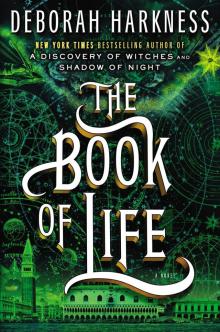 The Book of Life
The Book of Life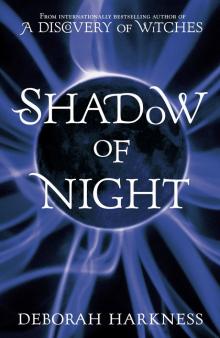 Shadow of Night
Shadow of Night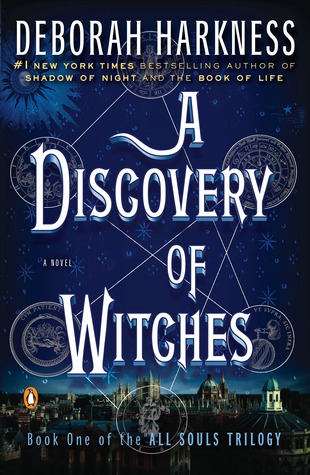 A Discovery of Witches
A Discovery of Witches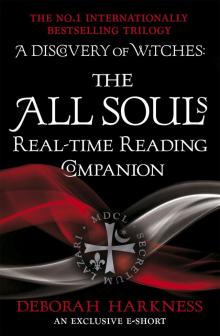 The All Souls Real-Time Reading Companion
The All Souls Real-Time Reading Companion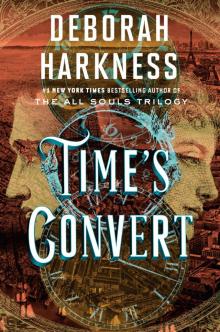 Time's Convert
Time's Convert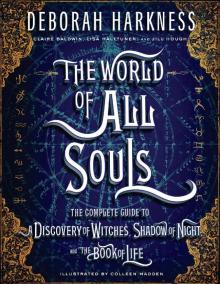 The World of All Souls
The World of All Souls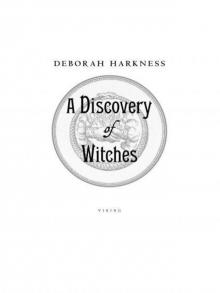 A Discovery of Witches: A Novel (All Souls Trilogy)
A Discovery of Witches: A Novel (All Souls Trilogy) Shadow of Night: A Novel
Shadow of Night: A Novel